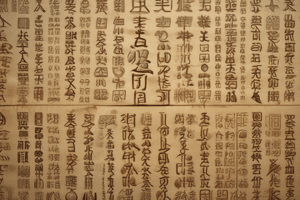Podcast
Questions and Answers
Which of the following technological advancements characterized the Shang Dynasty in ancient China?
Which of the following technological advancements characterized the Shang Dynasty in ancient China?
- Iron smelting for tool production
- Advanced agricultural techniques using irrigation systems
- Bronze craftsmanship for weapons and ritual objects (correct)
- Development of the printing press for mass communication
The primary function of oracle bones during the Shang Dynasty was religious worship.
The primary function of oracle bones during the Shang Dynasty was religious worship.
False (B)
Identify two major rivers that were central to the development of early Chinese civilizations.
Identify two major rivers that were central to the development of early Chinese civilizations.
Huang He (Yellow River) and Yangtze River
__________ was the first emperor of a unified China, beginning in 221 BCE.
__________ was the first emperor of a unified China, beginning in 221 BCE.
Match the following dynasties/periods with their notable characteristic:
Match the following dynasties/periods with their notable characteristic:
Flashcards
Yellow River
Yellow River
Also known as the Huang He, prone to flooding, earning it the nickname "China's Sorrow."
Rice Cultivation
Rice Cultivation
A primary crop in ancient China, cultivated as early as 8000 BCE.
Shang Dynasty
Shang Dynasty
Chinese dynasty known for its advancements in bronze craftsmanship.
Veneration of Ancestors
Veneration of Ancestors
Signup and view all the flashcards
Qin Shi Huang
Qin Shi Huang
Signup and view all the flashcards
Study Notes
- Early Chinese civilizations were primarily concentrated in the valleys of the Huang He/Yellow River and the Yangtze River
- Rice cultivation was present in the region by 8000 BCE
- By 5000 BCE, villages had been established
- Main crops included domesticated millet, wheat, and barley
- Silk weaving, wheel-thrown pottery, and metallurgy were developed skills
- The Shang Dynasty emerged around 1500 BCE, marking the beginning of the Bronze Age, known for its craftsmanship
- Matrilineal social structures evolved into patrilineal systems, indicating a stratified society
- Ancestor veneration and oracle bone divination were important, but these practices did not constitute a religion
- Writing emerged by approximately 1600 BCE, progressing from pictographs to symbols
- Towns existed by 4000 BCE, and cities developed by 1400 BCE
- Imperial China lasted from 221 BCE to 1912 CE, starting with Qin Shi Huang, known for his tomb with terracotta soldiers
Studying That Suits You
Use AI to generate personalized quizzes and flashcards to suit your learning preferences.




